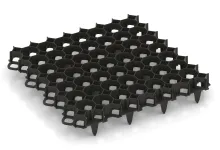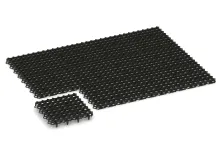Rubber sports surface HD TZ "Rattan Lounge"
- /
-
Delivery in approx.
2-3 weeks - £78.40 / 4 Piece / m²
- (6.51 kg / Piece)
EAN: 4251469341166 | Item no.: 4116
Heavily used sports courts require a particularly durable surface. The WARCO Rubber Sports Surface HD has been specially developed for areas subject to intensive use – such as basketball courts, soccer courts, multi-use pitches or playgrounds.
The handy 50 × 50 cm tiles are available in 3, 4 or 5 cm thickness. With their interlocking puzzle edges, the tiles fit together precisely to form a stable surface. Thanks to their higher density, the HD tiles offer greater abrasion resistance and provide a more consistent ball rebound. This makes them the ideal choice for schools, sports clubs or public courts exposed to heavy use.
Safety and playing comfort
The slip-resistant surface provides reliable grip in both wet and dry conditions. The elastic structure cushions impacts, protects joints, reduces noise and minimises the risk of injuries. At the same time, the higher density ensures a controlled and sport-appropriate ball rebound – ideal even for demanding training sessions.
Weatherproof and durable
The tiles are UV-resistant, frost-proof and withstand changing weather conditions. Rainwater drains through the open-pore structure, although more slowly than with the standard version. The surface remains functional, however, as no permanent puddles form. Even under heavy loads, the tiles remain dimensionally stable and visually appealing.
Versatile applications
The Rubber Sports Surface HD is suitable for a wide range of sports courts, both private and public. It can be laid vandal-proof and provides a long-term, economical solution for heavily used sports facilities. Line markings can easily be applied to the robust surface. Combining safety, durability and easy installation, this flooring is the ideal solution for long-lasting sports courts of any size.
Discount
Product Highlights
Characteristics
Product Details – Material and Structure
Comparative values
To calculate how many tiles you need for your project, simply use the online installation planner available in the shop. This free browser-based tool is directly accessible on each product page – just below the price and quantity selection. Click on “Plan installation” to open the tool instantly – no registration or download required.
Enter the dimensions of your area, such as the length and width in metres. The planner will then automatically calculate the total number of tiles required, including a realistic allowance for offcuts. You’ll also be shown a suitable layout pattern for the selected product. The tool is user-friendly, accurate and ideal for planning your material requirements with confidence.
Yes, that is the standard approach. The vast majority of our customers – whether private, municipal, or commercial – install the delivered WARCO tiles themselves or with their own staff. The installation is simple and requires no special skills. Only fitting the curb into a concrete foundation with back support demands a little extra craftsmanship. Cutting the elements to size and laying them on a suitable substrate is not challenging. You can find all essential installation information in our Expert Advice – FAQ section on our website.
WARCO offers several connection systems for floor tiles, each differing in design, installation method and visual appearance. Below is an overview of the key differences:
Puzzle joint (visible)
In this system, the tile edges feature an interlocking profile reminiscent of classic jigsaw teeth or mushroom-shaped connectors. During installation, the profiles of adjacent tiles interlock to form a continuous connection across the full tile thickness.
The joint profile may be formed directly during pressing or precisely cut after the tile has cured. Whether the joint is visible in the finished surface depends on the edge finish (e.g. with or without chamfer) and the surface colouration.
The symmetrical shape ensures uniform load transfer and makes this type of joint the most mechanically stable option.
Plug-in connectors (plastic dowels)
This system uses separate connecting elements, typically round plastic dowels, which are inserted into pre-drilled holes along the sides of the tiles. The tiles themselves have smooth, straight edges similar to precast concrete slabs.
Installation is carried out in a half-bond (stretcher bond) pattern: each tile is connected via dowels to two tiles in the row above and two in the row below. This prevents lateral shifting, although some movement along the length of the dowels remains possible. For this reason, an edge restraint must be installed around the perimeter to stabilise the entire area.
Concealed puzzle joint
This method is based on the same mechanical principle as the classic puzzle joint, but is designed to be invisible in the finished surface. The interlocking profile is located on the underside of the tile, integrated into a rebated step joint.
Two tile edges feature a positive locking profile, the other two a matching negative profile. When laid, the tiles interlock securely from below, forming a durable mechanical connection. From above, the surface appears seamless and aligned, typically with a clean, square joint pattern similar to a chessboard layout.















































